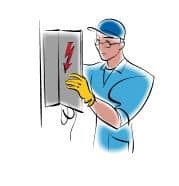Electrician Job Description Template Word
Are you looking for a comprehensive and customizable job description template for an electrician position? Look no further than the Electrician Job Description Template Word from Bizmanualz.
This template is designed to help you create a clear and concise job description that accurately reflects the duties and responsibilities of an electrician. It includes sections for job summary, essential duties and responsibilities, qualifications, physical demands, and work environment.
With this template, you can easily tailor the job description to your specific needs and requirements. You can add or remove sections as needed, and customize the language to match your company’s tone and style.
Using a job description template can save you time and effort in the hiring process. It ensures that all candidates are evaluated based on the same criteria, and helps to attract the most qualified and suitable candidates for the position.
Whether you are hiring for a residential or commercial electrician position, the Electrician Job Description Template Word can help you create a job description that accurately reflects the skills and experience required for the role.
Don’t waste any more time creating job descriptions from scratch. Download the Electrician Job Description Template Word today and streamline your hiring process.
 ELECTRICIAN SUMMARY OF FUNCTIONS
ELECTRICIAN SUMMARY OF FUNCTIONS
Design, lay out, assemble, install, test, and repair electrical fixtures, apparatus, and wiring used in a wide range of electrical systems that provide light, heat, refrigeration, air conditioning, and power.
ELECTRICIAN ESSENTIAL DUTIES AND RESPONSIBILITIES
- Follows blueprints, specifications, or verbal instructions and plans the intended location of wiring and equipment.
- Measures, cuts, assembles, and installs electrical wiring, stripping, splicing, and soldering as necessary.
- Attaches cables and wiring to the incoming electrical service and to various fixtures and machines that use electricity.
- Installs switches, circuit breakers, relays, transformers, grounding leads, signal devices, and other electrical components.
- Performs circuit testing for continuity and safety after installation, and makes adjustments as needed.
- Does all work in accordance with the National Electric Code as well as state and local building and electrical codes.
ORGANIZATIONAL RELATIONSHIPS
Reports to the Engineering Manager.
ELECTRICIAN QUALIFICATIONS
A high school diploma or GED is required; a diploma from a trade/vocational school is preferred. Completion of an electronics course is desired, as is good color vision and manual dexterity. Must enter the electrician’s apprentice program within 90 days of hire.
ELECTRICIAN PHYSICAL DEMANDS
Ability to communicate orally with project management and coworkers is important. Regular use of a variety of both handheld and motorized electrician’s tools is essential. Standing for extended periods is common. Hearing and vision within normal ranges is important for conversations, to receive ordinary information and to prepare or inspect building plans, blueprints, and drawings.
Heavy lifting is not expected. Exertion of up to 100 lbs. of force occasionally is required. Good manual dexterity for the use of common construction equipment, electrician’s tools, and scaffolding is required.
Good math and reasoning ability is essential. Able to apply statistical calculations, geometry, trigonometry, algebra, linear equations, and other analytics as required. Able to understand and utilize architectural or engineering drawings and equipment operating manuals to conduct business.
WORK ENVIRONMENT
The job may be performed both indoors and outdoors in a variety of settings including possible hazardous conditions on and around scaffolding or a construction site. Exposure to loud noises, dust, dirt, and smoke may occur. Protective safety clothing is required including appropriate construction grade boots, gloves, hardhat, goggles, pants, and shirt as required.
Activities include extended periods of standing and extensive work with electrician’s tools, measuring devices, and motorized or air-powered tools.























Reviews
There are no reviews yet.